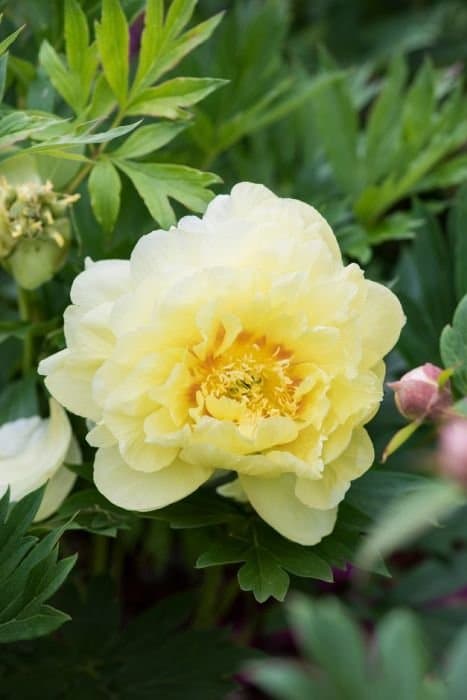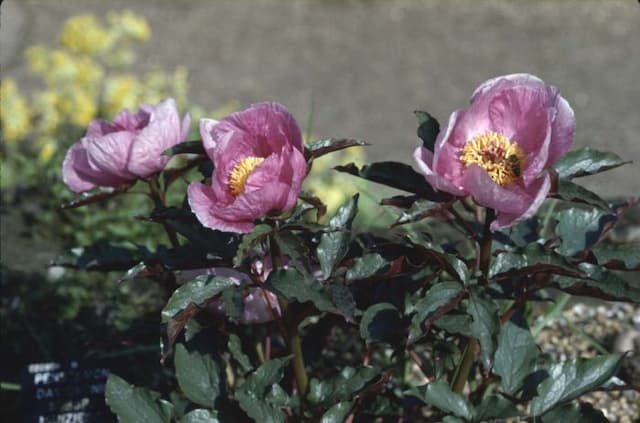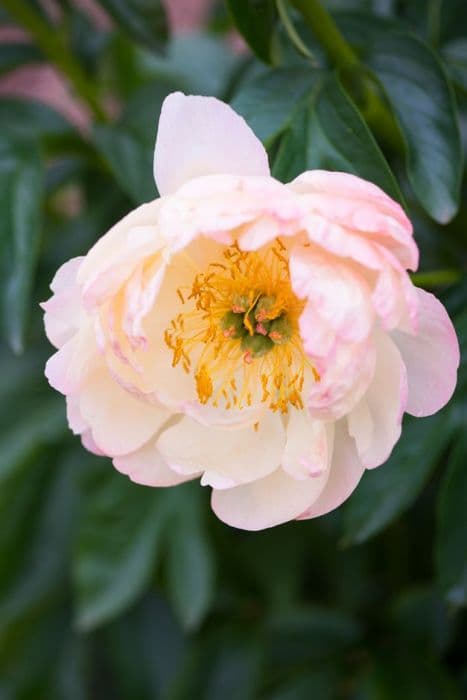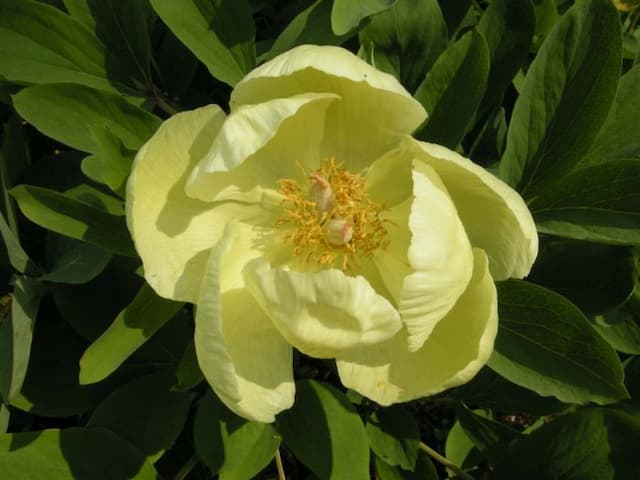Coral Charm Peony Paeonia 'Coral Charm'
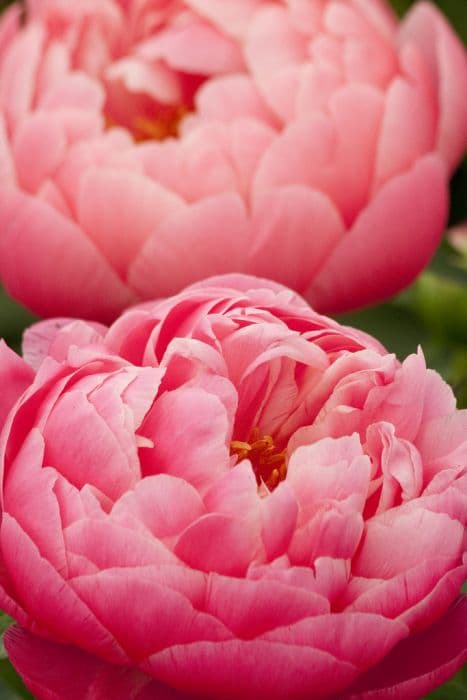
ABOUT
The Paeonia 'Coral Charm' is a stunning peony variety with an exceptional display of color and form. This plant boasts large, cup-shaped flowers that open into a magnificent semi-double bloom with petals beautifully arranged in a whorled pattern. The petals are a rich coral pink hue that gradually transitions to a softer peach tone at the edges as they age, before finally fading to a pale ivory. As the flowers mature, this progression of colors creates a delightful multi-toned effect. The large blossoms are supported by sturdy stems and stand out against the deep green foliage, which provides a lush backdrop for the vivid floral display. The leaves are compound with a glossy surface, adding to the plant's overall vigor and aesthetic appeal. The peony's flowers exude a light, pleasant fragrance that adds another layer of appeal to this gorgeous perennial plant.
About this plant
 Names
NamesFamily
Paeoniaceae
Synonyms
Coral Charm Peony
Common names
Paeonia 'Coral Charm'.
 Toxicity
ToxicityTo humans
Peonies like the 'Coral Charm' variety are generally considered non-toxic to humans. Ingesting parts of the plant is unlikely to cause serious harm, but it may cause mild gastrointestinal discomfort, such as nausea or diarrhea, due to the presence of compounds that can be mildly irritating. However, allergic reactions can be a concern for sensitive individuals upon handling the plant or ingesting its parts. There is no widespread documentation of severe poisoning in humans due to peonies, so they are often regarded as safe in gardens and homes from a toxicity standpoint.
To pets
Peonies, including the 'Coral Charm' variety, are considered toxic to pets, such as dogs and cats. If a pet ingests part of a peony plant, they may experience symptoms such as vomiting, diarrhea, and drooling. In severe cases, ingestion can lead to depression and lethargy. It is advisable to keep peonies out of reach of pets to prevent the risk of ingestion, even though severe toxicity is relatively uncommon. If you suspect your pet has ingested peony, consult a veterinarian.
 Characteristics
CharacteristicsLife cycle
Perennials
Foliage type
Deciduous
Color of leaves
Green
Flower color
Coral
Height
2-3 feet (0.6-0.9 meters)
Spread
2-3 feet (0.6-0.9 meters)
Plant type
Herbaceous
Hardiness zones
3-8
Native area
Asia
Benefits
 General Benefits
General Benefits- Striking blooms: Paeonia 'Coral Charm' produces vibrant coral-pink flowers that fade to a softer peach-pink, adding a burst of color to gardens.
- Attracts pollinators: The large flowers attract bees and butterflies, promoting biodiversity in the garden.
- Long-lasting cut flowers: These peonies have a lengthy vase life, making them ideal for floral arrangements.
- Durable perennial: As a hardy perennial, it returns year after year, reducing the need for annual replanting.
- Seasonal interest: In addition to springtime blooms, it offers attractive foliage throughout the summer and fall.
- Ease of care: Peonies generally require low maintenance after becoming established in a suitable location.
- Cold hardy: It can withstand cold winters, making it suitable for many temperate climates.
- Deer resistance: Peonies are less appealing to deer, deterring browsing in areas with high deer populations.
 Medical Properties
Medical PropertiesThis plant is not used for medical purposes.
 Air-purifying Qualities
Air-purifying QualitiesThis plant is not specifically known for air purifying qualities.
 Other Uses
Other Uses- Cut Flower Arrangements: 'Coral Charm' peonies are highly valued for their vibrant coral-colored blossoms which make striking cut flowers, often used in bouquets and floral arrangements.
- Wedding Decor: Due to their lush and romantic appearance, 'Coral Charm' peonies are commonly incorporated into wedding ceremony decor including centerpieces, bridal bouquets, and floral arches.
- Photography Prop: Photographers sometimes use 'Coral Charm' peonies as props or backdrops for spring-themed photo shoots due to their aesthetic appeal.
- Garden Theming: Gardeners might use 'Coral Charm' peonies to create a specific color-themed garden area, taking advantage of the plant's distinct coral hue to establish a monochromatic design.
- Culinary Decoration: Edible flowers are trendy, and the petals of peonies, while not specifically 'Coral Charm', may be used for ornate garnishing on cakes and desserts after ensuring they are free from pesticides and toxins.
- Artistic Inspiration: The vibrant color and form of 'Coral Charm' peonies provide inspiration to artists and are often depicted in paintings, textile designs, and other artistic mediums.
- Dried Flower Crafts: After the blooming season, 'Coral Charm' peony petals can be dried and used in potpourri, wreaths, or other dried flower crafts.
- Holiday Decorations: With their showy flowers, 'Coral Charm' peonies can be incorporated into festive decorations for events and holidays such as Easter or springtime celebrations.
- Natural Dye: Peony petals can be used to create natural dyes for fabrics or paper, though specific methods for 'Coral Charm' would need to be tested for color fastness and vibrancy.
- Educational Tool: In educational settings like schools or botanical workshops, 'Coral Charm' peonies can be used to teach about plant biology, hybridization, and garden design.
Interesting Facts
 Feng Shui
Feng ShuiThe Peony is often used in Feng Shui to promote love and romance. As the 'Coral Charm' Peony has a particularly vibrant hue, it could be placed in the southwest corner of a garden or room to enhance relationships and attract positive chi related to love and passion.
 Zodiac Sign Compitability
Zodiac Sign CompitabilityThe Peony is not used in astrology practice.
 Plant Symbolism
Plant Symbolism- Prosperity: Peonies, including the 'Coral Charm', are traditionally associated with wealth and good fortune, making them popular in celebrations that wish for prosperity.
- Romance: With its lush, full blooms, the 'Coral Charm' peony is often seen as a symbol of romantic love and is a popular choice for weddings and romantic occasions.
- Beauty: The striking coral hue and large blossoms of this variety of peony make it emblematic of beauty in its purest form.
- Honor and Nobility: In many cultures, peonies are associated with honor and high social status owing to their regal appearance.
- Good Luck and Happiness: Peonies are believed to bring good luck and happiness to the home, which is why they're often used in floral arrangements and decorations.
- Compassion: Some interpretations suggest that peonies, with their soft and inviting petals, symbolize compassion and empathy.
- Healing: Historically, peonies have been associated with healing properties, and their representation can extend to a symbolic hope for health and recovery.
 Water
WaterPeonies like 'Coral Charm' should be watered deeply once a week, providing about 1 inch of water which can be roughly equivalent to 0.6 gallons per square yard of soil. It's best to water in the morning to allow foliage to dry before nightfall, which reduces the risk of fungal diseases. During the growing season, make sure the soil around the peonies is kept moist but not waterlogged. Reduce watering after the blooming period as they enter dormancy and require less moisture. Ensure good drainage to prevent root rot.
 Light
LightPeonies such as 'Coral Charm' thrive in full sun to partial shade conditions. They require at least six hours of direct sunlight daily to bloom well. The ideal spot would be an area that gets morning sun and some afternoon shade, especially in hotter climates to prevent petal burn.
 Temperature
TemperaturePeonies like 'Coral Charm' perform best in temperatures between 65°F and 75°F. They can tolerate a winter chill and require a period of cold dormancy, with minimum winter temperatures around 30°F. However, they can be damaged by prolonged exposure to temperatures below 20°F or above 85°F.
 Pruning
PruningPeonies like 'Coral Charm' should be pruned to remove dead or weak stems in early spring to promote healthy growth and airflow. Deadhead spent flowers after blooming to maintain plant appearance. In the fall, after frost, cut back the foliage to ground level to prevent overwintering diseases. The best time for pruning is when the plant is dormant.
 Cleaning
CleaningAs needed
 Soil
SoilPeonies, including 'Coral Charm', thrive best in well-drained, fertile soil with a neutral to slightly alkaline pH, around 6.5 to 7.5. A good mix would be equal parts garden soil, compost, and perlite or sand to improve drainage. Avoid heavy clay soils and ensure good drainage to prevent root rot.
 Repotting
RepottingCoral Charm Peonies are typically grown as perennials in the garden and do not require frequent repotting. If grown in containers, repotting every 3-4 years or when the plant outgrows its current pot is usually sufficient.
 Humidity & Misting
Humidity & MistingPeonies like 'Coral Charm' can tolerate a wide range of humidity levels, but they prefer the moderate humidity found in many temperate climates. They do not require special humidity adjustments when grown in suitable outdoor garden conditions.
 Suitable locations
Suitable locationsIndoor
Grow in large pots with ample light, cool temps, and good air flow.
Outdoor
Plant in full sun to partial shade with well-draining soil.
Hardiness zone
3-8 USDA
 Life cycle
Life cycleThe life cycle of the Coral Charm Peony (Paeonia 'Coral Charm') begins with seed germination, which occurs in well-draining soil with adequate moisture and cool temperatures. Emerging seedlings develop into young plants with a basal set of leaves and a small root system, generally requiring a couple of years to establish themselves. As the plant matures, it forms a robust clump of herbaceous foliage, and in spring, it produces distinctive coral-pink buds that bloom into large, bowl-shaped flowers. After blooming, which typically occurs in late spring to early summer, the flowers fade and are followed by seed pods if fertilization has occurred. The plant then enters a period of vegetative growth and energy storage in its underground tuberous roots for the next blooming cycle. In fall, the peony’s foliage dies back and the plant becomes dormant, enduring winter before re-emerging the following spring.
 Propogation
PropogationPropogation time
Late fall
Propogation: The Paeonia 'Coral Charm', commonly known as Coral Charm Peony, is typically propagated through division, which is best done in the fall after the plant has finished flowering and gone dormant. To propagate by division, you carefully dig up the peony clump and gently separate it into smaller sections, making sure that each division has 3-5 eyes, which are the small reddish buds from which next year's shoots will grow. The divisions can then be replanted immediately in well-drained soil, ensuring that the eyes are planted no more than 2 inches deep to allow for proper growth. It's important to water the newly planted divisions thoroughly to help establish them.
